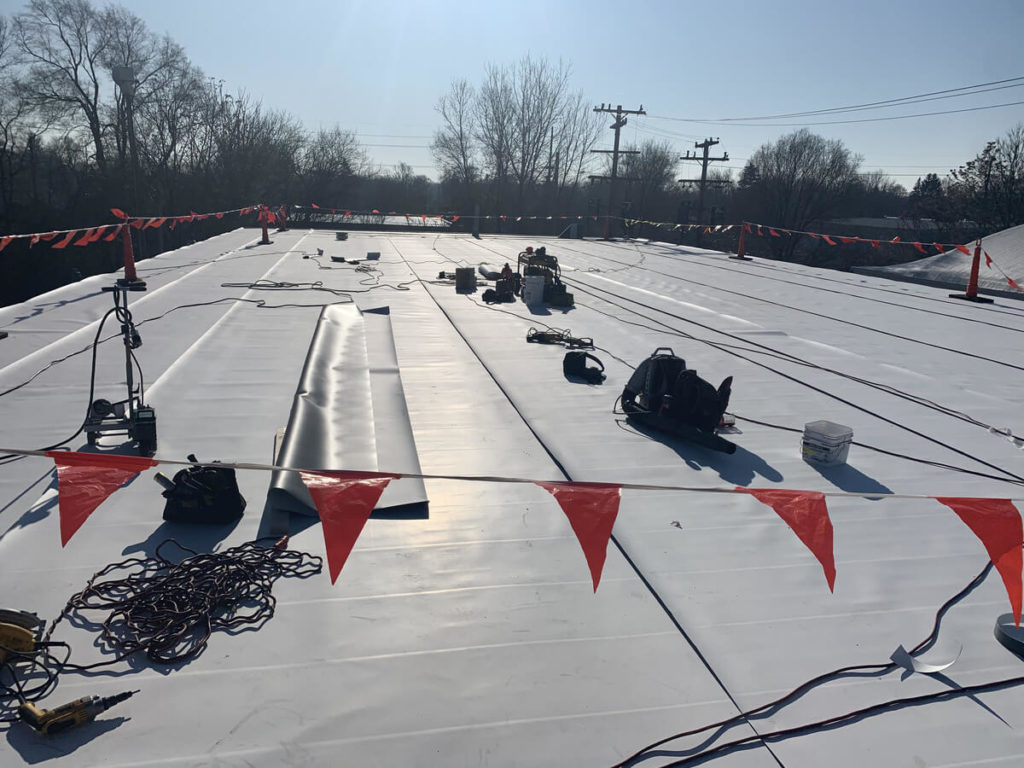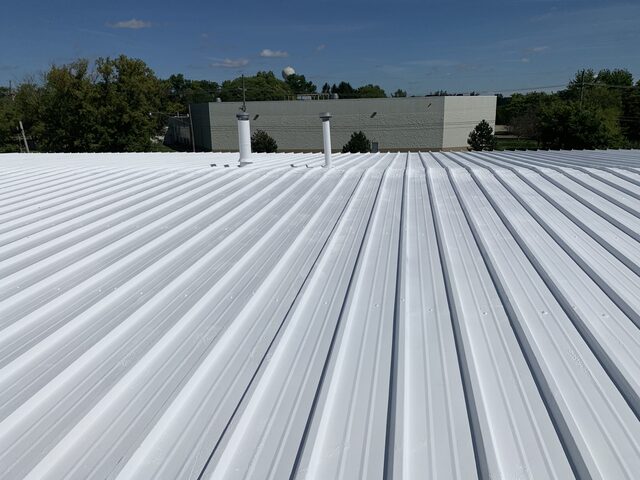The Vital Role of Commercial Roof Ventilation: Enhancing Building Health and Efficiency

If you own or manage a commercial building, you may not pay much attention to the roof ventilation system. However, this system plays a vital role in the health and efficiency of your building. Proper roof ventilation can improve indoor air quality, prevent moisture-related issues, reduce energy consumption, extend roof lifespan, and comply with building codes. In this article, we will explore the benefits of commercial roof ventilation and the factors that affect its design and installation.
Understanding Commercial Roof Ventilation
Roof ventilation is the process of allowing fresh air to enter and exit the roof space or attic of a building. This helps regulate the temperature and moisture levels in the roof and prevents heat buildup and condensation. Roof ventilation can be either passive or mechanical. Passive ventilation relies on natural forces such as wind and thermal buoyancy to create air movement. Mechanical ventilation uses fans or blowers to force air in or out of the roof space. Even flat or rolled commercial roofs need proper ventilation.
Improving Indoor Air Quality
One of the main benefits of roof ventilation is that it improves the indoor air quality of your building. Poor ventilation can lead to the accumulation of pollutants, moisture, and odors in the roof space, which can then seep into the living or working areas below. This can cause health problems for the occupants, such as allergies, asthma, headaches, and respiratory infections. Proper ventilation reduces these risks by diluting and removing contaminants from the roof space.
Preventing Moisture-Related Issues
Another benefit of roof ventilation is that it prevents moisture-related issues that can damage your roof and building structure. Moisture can accumulate in the roof space due to various sources, such as outdoor humidity, indoor activities, plumbing leaks, or roof leaks. Excess moisture can lead to mold growth, wood rot, rust, corrosion, insulation degradation, and electrical hazards. Proper ventilation prevents these problems by allowing moisture to escape before it can cause harm.
Energy Efficiency and Cooling
Roof ventilation also contributes to energy efficiency and cooling of your building. In the summer, heat from the sun can cause the roof space to become extremely hot, which can then radiate into the building below. This can increase the demand for air conditioning and raise your energy bills. Proper ventilation can reduce this heat gain by allowing hot air to escape from the roof space and bringing in cooler air from outside.
Extending Roof Lifespan
By preventing heat buildup and moisture damage, roof ventilation can also extend the lifespan of your roof. Excessive heat can cause roofing materials to expand and contract, which can lead to cracking, curling, blistering, or warping. Moisture can also cause roofing materials to deteriorate or decay over time. Proper ventilation can protect your roof from these effects by maintaining a stable temperature and moisture level in the roof space.
Compliance with Building Codes
Roof ventilation is not only beneficial but also required by many building codes and regulations. These codes specify the minimum amount and type of ventilation needed for different types of buildings and climates. The purpose of these codes is to ensure adequate indoor air quality, fire safety, structural integrity, and energy efficiency. Failing to comply with these codes can result in fines, penalties, or legal issues.
Types of Commercial Roof Ventilation
There are different types of roof ventilation systems that you can choose from depending on your building structure and needs. Some of the common types are:
- Static Vents: These are non-moving vents that allow air to pass through them.
- Turbine Vents: These vents use wind power to create suction and draw hot air out of the building.
- Power vents: These vents use electricity to power a fan that draws hot air out of the building. They are typically installed near the roof’s peak and can be used in conjunction with static vents.
Factors Affecting Ventilation Design
The design of your roof ventilation system should be tailored to your specific building conditions and requirements. Some of the factors that affect ventilation design are:
- Building size: The size of your building determines how much ventilation you need to achieve adequate air exchange.
- Climate: The climate of your location affects how much heat and moisture you need to deal with in your roof space.
- Occupancy: The occupancy of your building affects how much indoor-generated pollutants and moisture you need to remove from your roof space.
- Existing systems: The existing systems in your building, such as heating, cooling, plumbing, or electrical systems, may affect how you design your ventilation system.
Importance of Professional Installation
Installing a roof ventilation system is not a DIY project that you can do on your own. It requires professional skills and knowledge to ensure proper installation and performance. Some of the potential pitfalls of DIY approaches or subpar installations are:
- Improper sizing: If you install a ventilation system that is too small or too large for your building, you may not achieve adequate ventilation or waste energy.
- Improper placement: If you install vents in the wrong locations or orientations, you may create air leaks, drafts, or backdrafts that compromise ventilation efficiency and indoor comfort.
- Improper sealing: If you fail to seal the vents properly, you may allow water, dust, insects, or animals to enter your roof space and cause damage or health hazards.
Maintenance and Regular Inspections
Once you have installed a roof ventilation system, you need to maintain it regularly to ensure its efficiency and longevity. Some of the maintenance tasks that you should perform are:
- Cleaning: You should clean the vents and filters periodically to remove any dirt, debris, or obstructions that may reduce airflow or cause damage.
- Repairing: You should repair any cracks, holes, or damages that may affect the performance or safety of your ventilation system.
- Replacing: You should replace any worn-out or broken components that may compromise the functionality or durability of your ventilation system.
In addition to maintenance, you should also conduct regular inspections of your roof ventilation system to identify and address any issues promptly. Some of the signs that indicate a problem with your ventilation system are:
- High indoor temperature or humidity
- Condensation or mold growth in the roof space or building interior
- Roof leaks or stains
- Ice dams or icicles on the roof edge
- High energy bills or poor air quality
Return on Investment (ROI)
Investing in a proper roof ventilation system can provide you with significant financial benefits over the long term. Some of the potential savings that you can achieve are:
- Energy savings: By reducing the heat gain and cooling load of your building, you can lower your energy consumption and costs for air conditioning.
- Maintenance savings: By preventing moisture damage and heat deterioration of your roof and building structure, you can reduce your maintenance and repair costs.
- Replacement savings: By extending the lifespan of your roof and building components, you can delay or avoid the need for replacement costs.
Roof ventilation is a vital component of commercial building structures that can enhance their health and efficiency. By installing a proper roof ventilation system, you can improve indoor air quality, prevent moisture-related issues, reduce energy consumption, extend roof lifespan, and comply with building codes. To achieve optimal results, you should consult with professional contractors who can design and install a ventilation system that suits your specific building conditions and needs. You should also maintain and inspect your ventilation system regularly to ensure its performance and durability. By doing so, you can enjoy the benefits of roof ventilation and get a high return on your investment.
Need Advice on Commercial Roof Ventilation in the Detroit area?
This article was prepared by Silicoat Roofing, a premier commercial roofing contractor serving the greater Troy and Detroit, Michigan areas. If you’ve got a leak or a concern about your commercial building’s roof, call us at (248) 788-6010.


